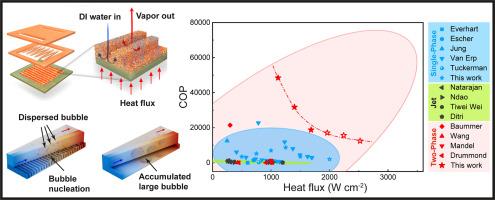超高热流通量SiC芯片的两相流沸腾冷却
IF 5.8
2区 工程技术
Q1 ENGINEERING, MECHANICAL
International Journal of Heat and Mass Transfer
Pub Date : 2025-10-03
DOI:10.1016/j.ijheatmasstransfer.2025.127885
引用次数: 0
摘要
虽然摩尔定律最近已经接近其物理极限,但电子产品的高集成度和小型化也带来了另一个热失效障碍。以往对单相流的研究需要大量的泵功率来达到更高的临界热流(CHF),这有超过芯片机械极限的风险,并使封装复杂化。第三代半导体的高结温(175°C以上)使其成为两相水冷却的理想选择,这种水冷却利用水沸腾时的巨大潜热来最小化流量并最大化性能系数(COP)。在这项工作中,我们设计了一个嵌入式分层微通道散热器,用于去离子水两相冷却的传热。分布歧管和分层微通道铜芯的结合在大量成核位点和优异的渗透率之间取得了平衡。我们观察到在流速为3.0 ml/s时CHF为1682 W/cm2, COP高达~ 19000,这意味着只需89 mW的功率就可以带走芯片上1682 W/cm2的热流,与流速相同的单相微通道相比,增加了3倍。该技术有望克服电子热管理的瓶颈。本文章由计算机程序翻译,如有差异,请以英文原文为准。

Two-Phase Flow Boiling for Ultra-High Heat Flux SiC Chip Cooling
While Moore's Law has approached its physical limits lately, the high integration and miniaturization of electronics have also brought another thermal failure obstacle. Previous studies on single-phase flow demanded significant pump power to achieve higher Critical Heat Flux (CHF), which risked exceeding the chip's mechanical limits and complicating packaging. The elevated junction temperature (above 175°C) of third-generation semiconductors makes them ideal for two-phase water cooling, which utilizes the huge latent heat during boiling of water to minimize the flow rate and maximize the Coefficient of Performance (COP). In this work, we designed an embedded hierarchical microchannel heat sink for heat transfer by deionized water two-phase cooling. The combination of the distribution manifold and the hierarchical microchannel copper wick achieves a balance between a large number of nucleation sites and excellent permeability. We observed an CHF of 1682 W/cm2 with COP up to ∼19000 at flow rate of 3.0 ml/s, which means Only 89 mW of power is needed to take away the heat flux of 1682 W/cm2 on a chip, corresponding to a 3-fold increase compared to single-phase microchannels with the same flow rate. This technology is anticipated to overcome the bottleneck in electronic thermal management.
求助全文
通过发布文献求助,成功后即可免费获取论文全文。
去求助
来源期刊
CiteScore
10.30
自引率
13.50%
发文量
1319
审稿时长
41 days
期刊介绍:
International Journal of Heat and Mass Transfer is the vehicle for the exchange of basic ideas in heat and mass transfer between research workers and engineers throughout the world. It focuses on both analytical and experimental research, with an emphasis on contributions which increase the basic understanding of transfer processes and their application to engineering problems.
Topics include:
-New methods of measuring and/or correlating transport-property data
-Energy engineering
-Environmental applications of heat and/or mass transfer

 求助内容:
求助内容: 应助结果提醒方式:
应助结果提醒方式:


